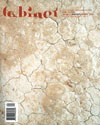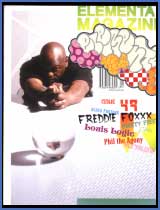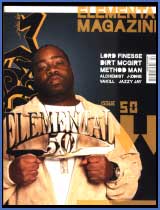The Print Magazine Is Not Dead: A Celebration of the Best, part one (continued)
by dave heaton
Cabinet
"Not a Joke: Free Land Inside!", proclaims a sticker on the cover of the Spring 2003 issue of Cabinet, a "quarterly magazine of Art and Culture." Intrigued? Well, you should be, by not just by that declaration. Everything about each issue of Cabinet piques your interest right away; it's a confounding, complicated, and enigmatic magazine. More importantly, it's filled with intelligent explorations and creations. Not just a magazine about art, it's also a work of art itself. The people behind the magazine are both intellectually inquisitive and artistically inclined, so each issue is filled with fascinating articles that take a subject from history, art, or the world around us and really delve into it in full but also with works of art, often including postcards, posters or other art-works as part of the magazine.
 Each issue has a theme (Weather, Animals, Evil, Childhood, etc.), and a large portion of that issue is given over to its theme. Yet the theme is always wide enough to take in a variety of subjects. The Spring issue's theme is "Property." As part of the themed section, there's not just the contract for a free piece of land hinted at from the cover sticker (the contract is for real, a contract for a piece of land in New Mexico that's the exact size of the magazine), but articles on a location in the Pacific Ocean where the US military dumped things they didn't want, a "dotcommunist manifesto" on freedom of ideas in the world of the Web, and numerous art projects (or reports on art projects) involving landscapes and locations. In addition to the themed section, there's numerous columns, interviews and articles on a variety of subjects, from weeds to the "Hot or Not" web site. To speak generally, Cabinet is a brilliant reservoir of ideas. Unlike anything most people think of when they hear the word "magazine," it's not only a great read but it's imminently not disposable.
Each issue has a theme (Weather, Animals, Evil, Childhood, etc.), and a large portion of that issue is given over to its theme. Yet the theme is always wide enough to take in a variety of subjects. The Spring issue's theme is "Property." As part of the themed section, there's not just the contract for a free piece of land hinted at from the cover sticker (the contract is for real, a contract for a piece of land in New Mexico that's the exact size of the magazine), but articles on a location in the Pacific Ocean where the US military dumped things they didn't want, a "dotcommunist manifesto" on freedom of ideas in the world of the Web, and numerous art projects (or reports on art projects) involving landscapes and locations. In addition to the themed section, there's numerous columns, interviews and articles on a variety of subjects, from weeds to the "Hot or Not" web site. To speak generally, Cabinet is a brilliant reservoir of ideas. Unlike anything most people think of when they hear the word "magazine," it's not only a great read but it's imminently not disposable.
Q&A: Sina Najafi, Editor-in-chief
In a sentence or two, how would you describe the vision behind Cabinet, what it's all about?
Art magazines have for too long been made from the critic's perspective (relying on the notions of judging, evaluating, excluding, canon building, and relying on myths such as "critical distance," etc). We wondered what it would be like to jettison all that and have an art and culture magazine that explores cultural issues with the same sense of curiosity, seriousness, lightheartedness, and commitment that artists today bring to the world around them.
In your most recent (or next) issue, which article are you most excited about, and why?
For our latest issue, which has a themed section on the notion of Property, the magazine made three very different land acquisitions which will form the basis of ongoing projects. One of the acquisitions was a half-acre of scrubland in New Mexico that we bought through Ebay. We've divided up the half-acre lot, dubbed Cabinetlandia, into several sections. Readerlandia consists of 6700 identical plots of land each exactly the size of Cabinet magazine, which serendipitously turned out to be the smallest size that most people can stand on. By returning a contract enclosed in the issue to us with a payment of one penny, readers can license one of these 6700 parcels of land until 31 December 2099. There is also Nepotismia for our friends, Internlandia, Funderlandia, and Artistlandia, which is reserved for artist projects that we will be commissioning. In July, artists Spencer Finch will be burying a gold coin on the land as part of a larger art project he's doing, and later this year we will be organizing a group trip to the New Mexico site and are inviting all reader-licensees to join us.
(The three land acquisition projects are offered as sample articles on our site through our current issue's table of contents online at http://www.cabinetmagazine.org/issues/10/. The Cabinetlandia project is at http://www.cabinetmagazine.org/issues/10/NM_land.php.}
What would you consider the most bizarre or unusual article you've ever published?
In our current issue, we invited the New York-based painter Leon Golub, now in his 80s, to have dinner with two other Leon Golubs whom we had found online and through the telephone directory. One of them is an astrophysicist at Harvard; the other is a psychoanalyst in New York. The three men's surreal and quite moving conversation was transcribed and printed.
How hard is it to keep the magazine going these days, in a time when plenty of magazines seem to come and go fairly quickly?
We are a non-profit and rely massively on a very talented pool of volunteer labor.
Some numbers might be interesting to people not in the magazine world. Our production cost is $8 per issue. From our cover price of $10, we recuperate roughly $2 from each issue sent out to the newsstand once the distributor and the retailer have taken their cuts. This is because the distribution networks in this country are set up with the assumption that magazines' main source of income will be advertising, not the revenues from newsstand sales, which are supposed to be the pocket change.
Subscriptions are much better for us insofar as we get $7 per issue but once you take postage, packaging, etc out of that, we're getting something like $5.50 per issue. All in all, the numbers are impossible.
Besides your own magazine, what is one of your other favorite print magazines, and why?
Things (England): well-written articles on the cultural history of specific objects (e.g.; aquariums)
Elemental
 I'll pick up any hip-hop magazine on the newsstand, to see what they're saying about what album or see who they've interviewed and what they have to say. But the only one that's still publishing which lingers for a while in my brain is Elemental. It's one of those deceptive magazines, that sneak up on you. On the surface it doesn't look especially big or unusual, yet read through an issue and you'll find that days later your mind will keep coming back to the articles you've read. Case in point: Issue 49 had a cover story on Freddie Foxxx (that itself says something, as he's eternally overlooked despite the fact that he's been a major presence in hip-hop almost since the music was born!) that was revealing and honest enough that I kept coming back to it. It the epitome of what a good interview should be: 1. It got straight to the point, without the writer being pretentious or showing off his writing skills 2. It took a global view of the musician, really going into his whole history, not just as a musician but as a person 3. It portrayed its subject in a realistic light, without worrying about hype 4. Because of all of these aspects, it made you feel like you really understood where he was coming from and what he was all about.
I'll pick up any hip-hop magazine on the newsstand, to see what they're saying about what album or see who they've interviewed and what they have to say. But the only one that's still publishing which lingers for a while in my brain is Elemental. It's one of those deceptive magazines, that sneak up on you. On the surface it doesn't look especially big or unusual, yet read through an issue and you'll find that days later your mind will keep coming back to the articles you've read. Case in point: Issue 49 had a cover story on Freddie Foxxx (that itself says something, as he's eternally overlooked despite the fact that he's been a major presence in hip-hop almost since the music was born!) that was revealing and honest enough that I kept coming back to it. It the epitome of what a good interview should be: 1. It got straight to the point, without the writer being pretentious or showing off his writing skills 2. It took a global view of the musician, really going into his whole history, not just as a musician but as a person 3. It portrayed its subject in a realistic light, without worrying about hype 4. Because of all of these aspects, it made you feel like you really understood where he was coming from and what he was all about.
One of the best things aboutElemental is its focus on hip-hop's past, present and future, equally. It also acknowledges the place of all aspects of hip-hop music and culture: more specifically, graffiti art is often well-integrated into the look of the magazine, and you're likely to find articles on graf writers, breakers, etc. along with the record reviews. Other pluses include a monthly opinion column from Chuck D (often a variation of what he posts on the PE web site), detailed and fair-minded reviews of albums, singles and mixtapes, and a "Films" section that often looks back on a film important to the hip-hop community (issue 47 had a great comparison of the original Shaft with the recent remake). And best of all, they don't waste time covering the mainstream, glossy version of hip-hop that the major record labels churn out to make quick cash. They cover the musicians that people who truly love hip-hop for what it is and what it has been (and who know what it has been) will want to read about.
Q&A: Matt Wright, Publisher
In a sentence or two, how would you describe the vision behind Elemental Magazine, what it's all about?
Elemental has always been about giving exposure to the underexposed. Too many magazines are afraid to dive in and take a chance, so they cover all of the same people all of the time. Even as Elemental has gotten huge, we always maintain an underground focus, giving shine to cats who are doing for self.
 In your most recent (or next) issue, which article are you most excited about, and why?
In your most recent (or next) issue, which article are you most excited about, and why?
Our editor for the past year, Mike Piroli, has taken the magazine in a number of very important directions. One of the strongest things he has brought to the table has been the desire to document the history of many of the most important hip-hop influences of the 1990s. We ran the most in-depth interview ever published with GZA of Wu-Tang. We sat down with Guru and Premier to uncover the most comprehensive Gang Starr story ever printed. In issue 50 of Elemental, we launched a definitive history of D.I.T.C., starting with Lord Finesse. It will be a 7-part series, ending with the late Big L.
What would you consider the most bizarre or unusual article you've ever published?
Not too many bizarre pieces in Elemental, but we do the unusual by going the extra mile to get real interviews about real history and issues in hip-hop. Our interviews are all-day affairs, not 30-minute phone conversations. See examples above...
How hard is it to keep the magazine going these days, in a time when plenty of magazines seem to come and go fairly quickly?
Magazines seem to come and go by the week, but we remain unaffected by these market fluctuations. Elemental has remained solid through its entire 5-year existence, and by sticking to what we know is important and avoiding trends and gimmicks, the magazine has built a rock solid reputation. Advertisers respect this and spend their money wisely.
Besides your own magazine, what is one of your other favorite print magazines, and why?
European Car, because I like to drive fast as fuck.
{Continue to the next page for more.}
Copyright (c) 2005 erasing clouds |
|